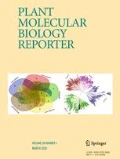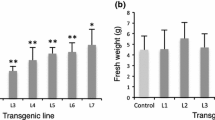Abstract
The full genomic region of the root knot nematode (Meloidogyne spp.) resistance gene Mi-1 was cloned from tomato and transformed into lettuce to investigate its function in a heterologous system. Transgenic lettuce lines containing the Mi-1 gene were developed using Agrobacterium-mediated transformation. Ectopic expression of the Mi-1 gene was observed in transgenic lines, and resistance to root knot nematode was improved.





Similar content being viewed by others
Abbreviations
- MS:
-
Murashige and Skoog medium
- BA:
-
6-Benzyladenine
- NAA:
-
α-Naphthaleneacetic acid
- SDS:
-
Sodium dodecyl sulfate
- NPTII :
-
Neomycin phosphotransferase gene
- PCR:
-
Polymerase chain reaction
- RT-PCR:
-
Reverse transcription-polymerase chain reaction
- FAA:
-
Formalin–acetic acid–alcohol
- UTR:
-
Untranslated region
References
Ammiraju JSS, Veremis JC, Huang X, Roberts PA, Laloshian I (2003) The heat-stable root-knot nematode resistance gene Mi-9 from Lycopersicon peruvianum is localized on the short arm of chromosome 6. Theor Appl Genet 106:478–484
Bakhetia M, Charlton WL, Urwin PE, Mcpherson MJ, Atkinson HJ (2005) RNA interference and plant parasitic nematodes. Trends Plant Sci 10:362–367
Chen RG, Li HX, Zhang LY, Zhang JH, Xiao JH, Ye ZB (2007) CaMi, a root-knot nematode resistance gene from hot pepper (Capsium annuum L.) confers nematode resistance in tomato. Plant Cell Rep 26:895–905
Dangl J, Jones J (2001) Plant pathogens and integrated defense responses to infection. Nature 411:826–833
Djian-caporalino C, Fazari A, Arguel MJ, Vernie T, Vande casteele C, Faure I, Brunoud G, Pijarowski L, Palloix A, Lefebvre V, Abad P (2007) Root-knot nematode (Meloidogyne spp.) Me resistance genes in pepper (Capsicum annuum L.) are clustered on the P9 chromosome. Theor Appl Genet 114:437–486
Flor HH (1971) Current status of the gene-for-gene concept. Annu Rev Phytopathol 9:275–296
Funk VA, Bayer RJ, Keeley S, Chan R, Watson L, Gemeinholzer B, Schilling E, Panero JL, Baldwin BG, Garcia-Jacas N, Susanna A, Jansen RK (2005) Everywhere but Antaractica: using a supertree to understand the diversity and distribution of the Compositae. Biol Skr 55:343–374
Goggin FL, Shan G, Williamson VW, Ullman DE (2004) Instability of Mi-mediated nematode resistance in transgenic tomato plants. Mol Breed 13:357–364
Goggin FL, Jia LL, Shah G, Hebert S, Williamson VM, Ullman DE (2006) Heterologous expression of the Mi-1.2 gene from tomato confers resistance against nematodes but not aphids in eggplant. Mol Plant Microbe Interact 19:383–388
Gomes LAA, Maluf WR, Campos VP (2000) Inheritance of the resistant reaction of the lettuce cultivar ‘Grand Rapids’ to the southern root-knot nematode Meloidogyne incognita (Kofoid & White) Chitwood. Euphytica 114:37–46
Jacquet M, Bongiovanni M, Martinez M, Verschave P, Wajnberg E, Castagnone-Sereno P (2005) Variation in resistance to the root-knot nematode Meloidogyne incognita in tomato genotypes bearing the Mi gene. Plant Path 54:93–99
Jadão AS, Krause-Sakate R, Liberti D, Pava MA, Echer MM, Svanella-Dumas L, Zerbin IF, Candresse TLE, Gal O (2007) Further characterization of two sequiviruses infecting lettuce and development of specific RT-PCR primers. Arch Virol 152:999–1007
Keen NT (1990) Gene-for-gene complementarities in plant–pathogen interactions. Annu Rev Phytopathol 24:447–463
Kerr JP, Hewett EW, Aitken AG (2003) Horticulture facts and figures. The horticulture and food research institute of New Zealand Ltd. Palmerston North, New Zealand
Lambert KN, Tedford EC, CaswelL EP, Williamson VM (1992) A system for continuous production of root-knot nematode juveniles in hydroponic culture. Phylopathology 82:512–515
Milligan SB, John B, Yaghoobi J, Kaloshian I, Zabel P, Williamson VM (1998) The root nematode resistance gene Mi from tomato is a member of the leucine zipper, nucleotide binding, leucine-rich repeat family of plant genes. Plant Cell 10:1307–1319
Murashige T, Skoog F (1962) A revised medium for rapid growth and bio assays with tobacco tissue culture. Physiol Plant 15:473–497
Nombela G, Williamson VW, Muniz M (2003) The root-knot nematode resistance gene Mi-1.2 of tomato is responsible for resistance against the whitefly Bemisia tabaci. Mol Plant Microbe Interact 16:645–649
Omuega CO, Thomason IJ, Roberts PA (1988) A non-destructive technique for screening bean germplasm for resistance to Meloidogyne incognita. Plant Dis 72:970–972
Pink DAC, Keane EM (1993) Lettuce Lactuca sativa L. In: Kallo G, Bergh BO (eds) Genetic improvement of vegetable crops. Pergamon, Great Britain, pp 153–160
Roberts PA, Thomason IJ (1986) Variability in reproduction of isolates of Meloidogyne incognita and M. javanica on resistant tomato genotypes. Plant Dis 70:547–551
Rossi M, Goggin FL, Milligan SB, Kaloshian I, Ullman DE, Williamson VM (1998) The nematode resistance gene Mi of tomato confers resistance against the potato aphid. Proc Natl Acad Sci USA 95:9750–9754
Widmer TL, Ludwig JW, Abawi GS (1999) The northern root-knot nematode on carrot, lettuce, and onion in New York. New York’s Food and Life Sciences Bulletin, Number 156. Cornell University, NYSAES, Geneva
Williamson VM (1998) Root-knot nematode resistance genes in tomato and their potential for future use. Annu Rev Phytopathol 26:277–293
Williamson VM, Hussey RS (1996) Nematode pathogenesis and resistance in plants. Plant Cell 8:1735–1745
Yaghoobi J, Kaloshian I, Wen Y, Williamson VM (1995) Mapping a new nematode resistance locus in Lycopersicon peruvianum. Theor Appl Genet 91:457–464
Acknowledgments
The authors thank Dr Zhangjun Fei (Boyce Thompson Institute for Plant Research, Cornell University) for critical review of this manuscript. This work was supported by grants from Major State Basic Research Development Program (2009CB119000), National Nature Science Foundation of China (no. 30800756 and no. 30671417), and Xinjiang Corps Doctor Fund of China (no. 2008JC04).
Author information
Authors and Affiliations
Corresponding author
Additional information
L.-Y. Zhang and Y.-Y. Zhang contributed equally to the work.
Rights and permissions
About this article
Cite this article
Zhang, LY., Zhang, YY., Chen, RG. et al. Ectopic Expression of the Tomato Mi-1 Gene Confers Resistance to Root Knot Nematodes in Lettuce (Lactuca sativa). Plant Mol Biol Rep 28, 204–211 (2010). https://doi.org/10.1007/s11105-009-0143-y
Received:
Accepted:
Published:
Issue Date:
DOI: https://doi.org/10.1007/s11105-009-0143-y




